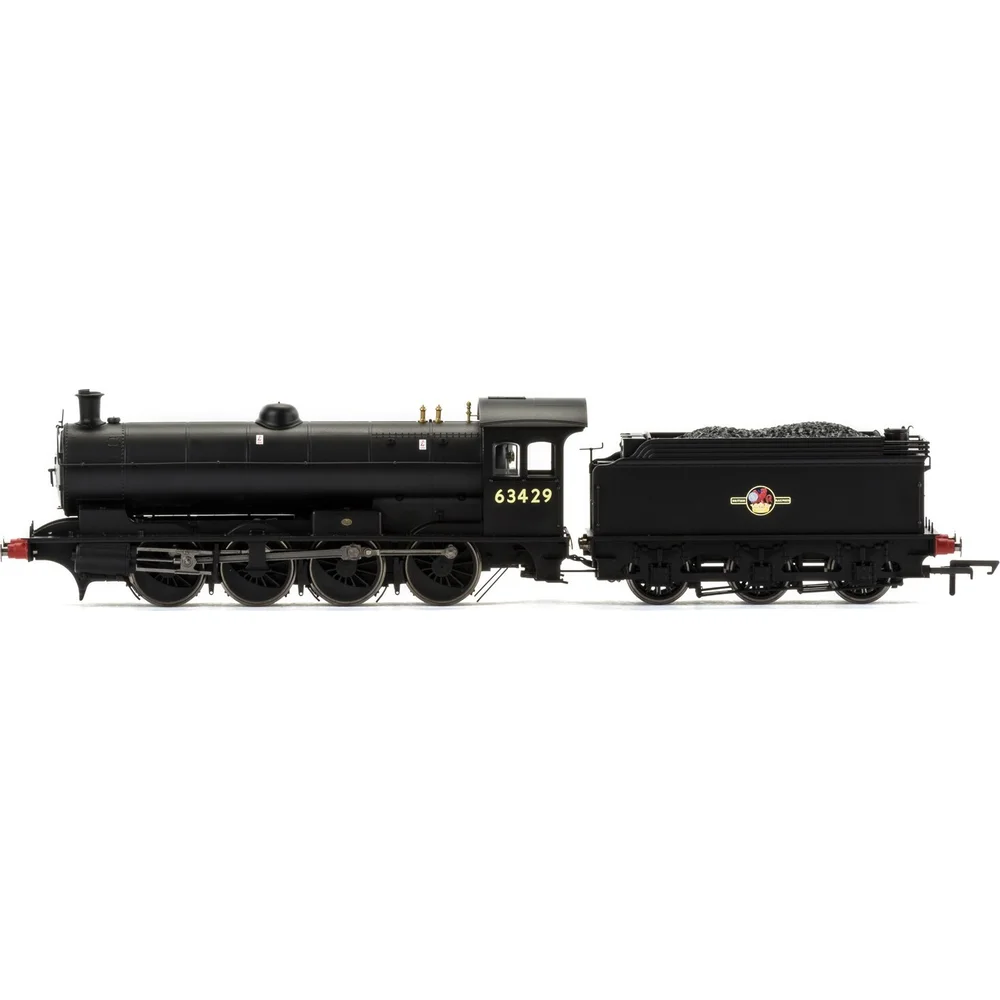Hornby R3426
London & North Eastern Railway Q6 63429 British Railways Black with Late Crest
Class & Prototype
- Class: London & North Eastern Railway Q6
- Traction: Steam
- Built: 1913-1921
- Total Built: 120
- Running Number: 63429
- Ordered By: North Eastern Railway
- Built By: Armstrong Whitworth
- Built At: Armstrong Whitworth
- Built: 05/1920
- Withdrawn: 07/1967
- Length of Service: 47.2 years
- Running Numbers: NER 2272, LNER 3429, BR 63429
- Names: -
Vincent Raven's NER Class T2, later classified as LNER Q6, represents one of Britain's most successful freight locomotive designs. Built between 1913-1921, these 120 robust 0-8-0 locomotives were specifically engineered for heavy coal traffic from Yorkshire and Durham collieries. Notable for being the first NER freight class with superheaters fitted as standard, they could handle 1,400-ton trains with remarkable reliability. The class served for 54 years across four railway companies (NER, LNER, BR, and preservation), with final withdrawal in 1967. Only locomotive 63395 (originally NER 2238) survives, preserved and operational on the North Yorkshire Moors Railway. Their combination of power, economy, and longevity established new standards for British freight locomotive design, making them highly sought-after subjects for railway modellers seeking authentic industrial heritage representation.
Operator & Livery
- Operator: British Railways
- Livery: Black with Late Crest
- Era: 5 - British Railways Late Crest
British Railways transformed Britain's fragmented rail network into a unified national system following nationalisation on 1st January 1948. Created from the "Big Four" companies under the Transport Act 1947, BR operated most of Great Britain's railways until rebranding as British Rail in 1965, managing over 20,000 route miles and inheriting nearly 20,000 locomotives of diverse designs.
The organisation pioneered standardisation through its revolutionary BR Standard locomotive programme (1951-1960), producing 999 advanced steam engines under Robert Riddles' direction. These included the versatile Britannia Pacifics, mighty 9F freight engines, and mixed-traffic classes that incorporated the best features from all predecessor companies. The 1955 Modernisation Plan accelerated diesel and electric traction development, creating fascinating mixed-traction operations.
Notable achievements included establishing unified locomotive classification systems, introducing distinctive corporate liveries, and managing the complex transition from steam to modern traction. BR's six regional structure preserved operational diversity whilst enabling standardisation of practices, signalling, and rolling stock that had eluded private enterprise for over a century.
The BR era represents steam traction's final flowering alongside emerging diesel technology, creating unparalleled locomotive variety. Today, this heritage remains highly popular with railway enthusiasts through extensive preserved fleets, heritage railway operations, and comprehensive model ranges from manufacturers like Hornby, Bachmann, and Dapol, making BR subjects essential for authentic post-war British railway modelling across all scales.
British Railways' plain black livery remained the standard finish for freight and shunting locomotives from 1956 onwards, representing the most economical and practical scheme for inherently dirty industrial operations. Plain black locomotives retained red buffer beams and received white lettering in Gill Sans style, maintaining the utilitarian approach established in the early BR period. The livery was applied to a vast range of locomotive types, from powerful freight engines like the 9F class down to humble shunting locomotives and industrial engines working in goods yards, collieries, and freight terminals.
From 1956, these locomotives received the new "Lion and Crown" emblem (nicknamed the "Ferret and Dartboard"), a proper heraldic device featuring a rampant lion emerging from a crown and holding a spoked wheel, enclosed in a roundel with "British Railways" displayed on bars either side. Unlike earlier practice, the new emblem was positioned centrally on tender sides or tank sides without reference to axle boxes, following heraldic conventions with the lion facing left. This livery period coincided with increasing neglect as steam operations wound down, with locomotives often covered in layers of grime that obscured the paintwork and made the already austere black finish appear even more weathered. The plain black finish continued until individual locomotives were withdrawn from service, with many examples lasting into the final years of steam operation in 1968. For modellers, this livery represents the twilight of steam freight operations, capturing the workaday reality of British Railways' industrial locomotive fleet during the final phase of steam traction.
